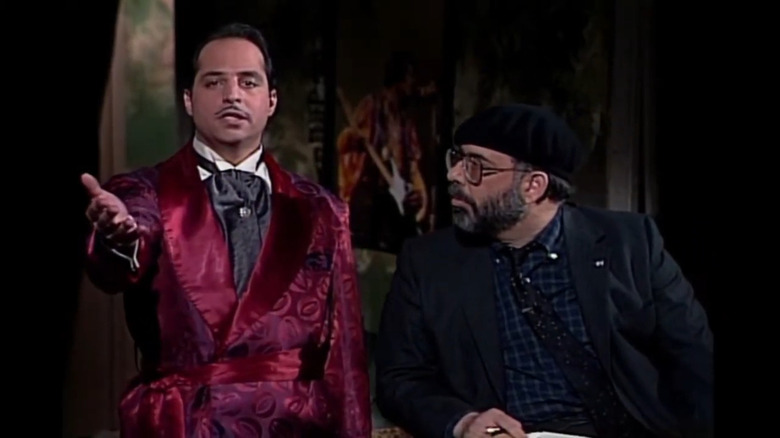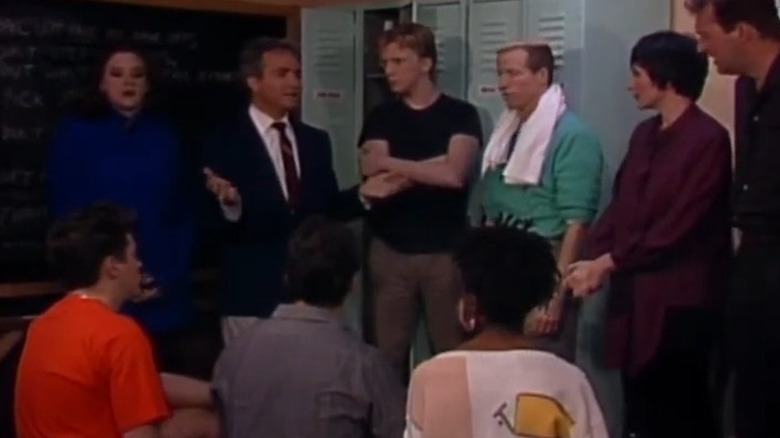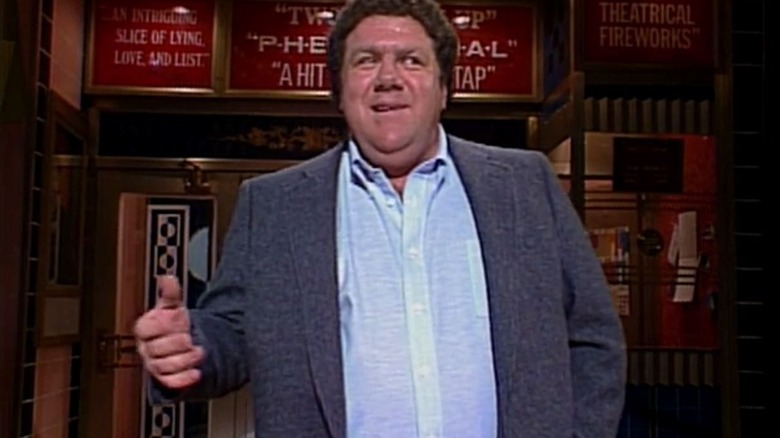Francis Ford Coppola's Saturday Night Live Episode Might Just Be The Weirdest
The '85/'86 year was a weird, weird season of "Saturday Night Live," a show that had any number of bad ones. SNL has remained an institution, curiously even through a regular series of slumps and mistakes. Try watching a complete episode during the daylight hours, and one will find a lot of lulls, bad ideas, and weird characters that never caught on. Throughout, however, enough talented comedians and sketches eked their way through to remain entrenched in the consciousness. Plus, celebrities and musical acts seemingly never lost their appetite for guest hosting, often drawing in big crowds just for their star appeal.
The show's 11th season was the first without its co-creator and star producer Lorne Michaels behind the scenes. He was replaced by NBC's Sports executive Dick Ebersol, and he seemingly didn't know what he was doing when it came to comedy. Ebersol once asked NBC if he could shutter SNL entirely and rework it from the ground up. He was rejected and Ebersol ended up quitting after less than a year on the job. There were rumors that SNL may finally be at an end. Michaels eventually came back, re-stuffed the cast, and was eager to experiment with new ideas to pump up his ailing franchise. This was the year that Robert Downey, Jr., Joan Cusack, and Anthony Michael Hall were in the cast. Yes, it was all real. Yes, it was all strange and weird.
One of Michaels' weirder experiments remains in the halls of legend. When George Wendt hosted the show, Michaels had "hired" star director Francis Ford Coppola to helm/co-host an episode. The gag would be that Coppola would constantly enter the frame to direct actors, live on camera.
It went over like a lead balloon.
The pep talk
The episode in question aired on March 22, 1986, and it began with Lorne Michaels, appearing on the show, announcing that Coppola will be stepping in to direct. The filmmaker behind "The Godfather" and "Apocalypse Now" was well-respected in 1979, but by 1986, he was something of a laughing stock. His 1982 film "One from the Heart" was one of the director's more notorious bombs, and even his films "The Outsiders," "Rumble Fish," and "The Cotton Club" were generally only well-liked rather than beloved. It didn't help that Coppola had gained a reputation for being a raving egomaniac, a reputation spoken aloud on SNL by cast member Terry Sweeney (incidentally, the first openly gay cast member of SNL).
During many sketches, Coppola would appear on stage and tell the actors, quite earnestly, how to better play the scene. He appeared to Wendt during the opening monologue, telling the comedian to think of an incident from his childhood in order to make his performance more believable. As a marginal cartoon in MAD Magazine, maybe that joke would have worked. As a running gag on a 90-minute program, it was death. There was no energy. It's clear that Coppola was no actor.
While athletes, politicians, Elon Musk, and other non-actors have appeared on SNL throughout its history, the writers at least penned sketches to operate around them. The comedians would do the heavy lifting while the non-performer delivered a punchline or tolerantly took it on the chin. Michaels frustratingly allowed Coppola to take up a lot of real estate. The only one who wrested control from the director was Jon Lovitz in character as the Master Thespian.
Why Coppola?
Why Coppola? It could be that Coppola represented an era of Hollywood filmmaking that had pretty much come to an end by the 1980s. Throughout the previous decade, a new generation of filmmakers came to the fore, making a series of headier, edgier dramas that were all enormous hits. 1969 saw "Midnight Cowboy" win Best Picture. Martin Scorsese started to appear with energetic, violent crime dramas. "The Exorcist" was a hit, as was the horror film "Jaws." And, yes, Coppola was in the center of it all with his first two "Godfather" movies. One might point directly to George Lucas' space adventure film "Star Wars" as the turning point in Hollywood trends. That film was such a juggernaut, that Hollywood began turning to sci-fi and lightweight, effects-driven pictures as their cash cows. By 1983, "Return of the Jedi" had been released, and mainstream adult dramas were withering.
Coppola's presence on SNL was perhaps a cry for audiences to remember when movies were good, or at least headier and more adult. The live audience seemingly enjoyed Coppola's presence, although audiences at home may be left scratching their heads. The conceit was fine — a high-end director brings too much ambition to a comedy show — but the execution was stodgy. Few clips exist, but combing YouTube reveals the oddness of it all.
An AV Club article details the episode's ending as a long crane shot, and an off-the-cuff epilogue of Wendt describing the episode as "The horror, the horror." it seems that SNL was trying to go a little meta with its presentation, dissecting itself from within. On an artistic level, that may be fascinating. As comedy, it proved terrible.


